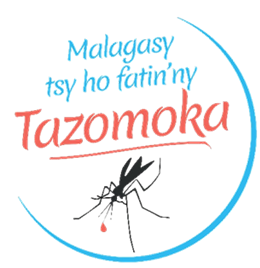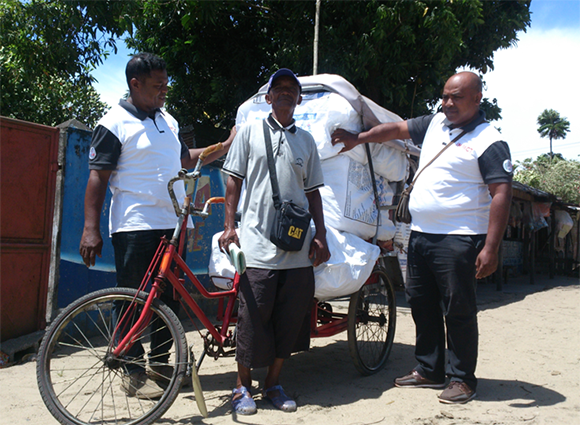Background
 To maintain universal coverage of insecticide-treated mosquito nets (ITNs) the community-based continuous distribution (CCD) strategy has been part of the overall national malaria prevention strategy of the Ministry of Public Health (MPH) of Madagascar since 2016, complementing ITN mass distribution campaigns and routine distribution through health facilities.
To maintain universal coverage of insecticide-treated mosquito nets (ITNs) the community-based continuous distribution (CCD) strategy has been part of the overall national malaria prevention strategy of the Ministry of Public Health (MPH) of Madagascar since 2016, complementing ITN mass distribution campaigns and routine distribution through health facilities.
The CCD strategy, which targets 14 districts in 2022—2023 (including special populations), consists of:
- Identifying sleeping spaces that are not covered by ITNs in all households following the mass distribution campaign (e.g. in cases of absence during registration or during the distribution period, or where the ITNs received were insufficient in relation to the number of sleeping spaces).
- Supplying ITNs to these households to cover the sleeping spaces not covered by the previous mass distribution campaign.
- Replacing existing torn or damaged ITNs.
Fourteen highly endemic districts have been prioritized for the 2022—2023 CDD, which has been implemented since October 2022 and will continue until September 2023):
 Marovoay
Marovoay- Miandrivazo
- Belo Sur Tsiribihana
- Mahanoro
- Nosy-Varika
- Ifanadina
- Mananjary
- Ikongo
- Vohipeno
- Iakor
- Farafagana
- Vangaindrano
- Port-Bergé
- Toamasina II
The overall strategy for the CCD consists of three areas:
- Coordination, planning and advocacy
- Logistics
- Communication
1. Coordination, planning and advocacy
The successful implementation of CCD is based on a strong partnership between the MPH through the National Malaria Control Programme (NMCP), the Ministry of Education (MoE) through the Department of Basic Education and Early Childhood (DBEEC) and the IMPACT Project, funded by USAID/PMI.
A coordinating committee exists at each level (national, regional, district, “commune” and community level) made up of representatives from MPH, MoE, the local community and PSI/IMPACT.
All stakeholders, whatever their level, are jointly responsible for supervision throughout the implementation of the CCD.
2. Logistics
 PSI/IMPACT supports the Government of Madagascar’s CCD by purchasing ITNs and transporting them to the community level. With the objective of decentralizing and encouraging local development, the project works with transporters to ship ITNs to district stores, either at MPH district-managed pharmacies, or at IMPACT-supported community relay supply points. The ITNs are then transported to the communal warehouses managed by the Basic Health Centres (MPH community pharmacies), or to the IMPACT-supported supply points.
PSI/IMPACT supports the Government of Madagascar’s CCD by purchasing ITNs and transporting them to the community level. With the objective of decentralizing and encouraging local development, the project works with transporters to ship ITNs to district stores, either at MPH district-managed pharmacies, or at IMPACT-supported community relay supply points. The ITNs are then transported to the communal warehouses managed by the Basic Health Centres (MPH community pharmacies), or to the IMPACT-supported supply points.
Technical Assistants (TAs) and TA supervisors have been set up by the project in these districts to support the local government team in carrying out the CCD. In addition, the project implements the payment of actors involved in the distribution of the ITNs via a mobile money system or direct payment.
For the actual distribution of ITNs, each month a sufficient number of nets to ensure continuity of distribution to households is taken from communal stores by community agents (Komity Mitantana ny Lay – Kom’Lay) and distributed to community sites.
3. Communication
 The CCD strategy maximizes awareness by using different types of communication strategies such as sensitization during community meetings, home visits by community health workers (CHWs), and awareness-raising by their teacher at school for eighth grade children. In public elementary schools, teachers also use interpersonal communication with pupils in the eighth grade to identify households with uncovered sleeping spaces and request the children to convey key messages to their parents. When schools have compiled a list of households with uncovered sleeping spaces, this is shared with village chiefs so that CHWs can visit the households and provide them with a coupon that can be exchanged for ITNs.
The CCD strategy maximizes awareness by using different types of communication strategies such as sensitization during community meetings, home visits by community health workers (CHWs), and awareness-raising by their teacher at school for eighth grade children. In public elementary schools, teachers also use interpersonal communication with pupils in the eighth grade to identify households with uncovered sleeping spaces and request the children to convey key messages to their parents. When schools have compiled a list of households with uncovered sleeping spaces, this is shared with village chiefs so that CHWs can visit the households and provide them with a coupon that can be exchanged for ITNs.
The various communication tools (communication guides, posters, bracelets, stickers, etc.) and CCD management tools were produced with support from PSI/IMPACT.
CCD distribution mechanism
- Community mobilizers conduct household visits or surveys in their constituencies to identify households with sleeping spaces that are not covered by an ITN, and when found they issue a voucher.
- On scheduled distribution days, household members then go to a community distribution site staffed by a community agent to collect their ITN in exchange for the voucher.
- At district level, paper reports from community distribution sites, which then pass through Basic Health Centres for verification and compilation, are finally centralized in the DHIS2 (or District Health Information Software 2) as part of the national data system.
Implementation
For 2016, ten pilot districts benefited from “continuous community-based distribution” during which ITNs were distributed on the basis of a pull system. In 2020, between January and December, 786,281 ITNs were distributed in 12 districts.
The distribution target for the CCD from October 2022 to September 2023 is 870,950 ITNs, covering all 14 districts. In October 2022, ten districts started the CCD process. The remaining four districts started distribution after the baseline assessment in April 2023.
To mitigate against the pyrethroid resistance identified in two districts (Port-Bergé and Toamasina II) PBO ITNs were distributed.
Evaluation
An initial evaluation of the CCD system was carried out in 2017 in the four districts of Vavatenina, Soanierana Ivongo, Vohipeno and Vondrozo. The results of this study showed the relevance of the new approach, which was then extended to a total of 12 districts in 2020.
For the current CCD, a baseline evaluation in April 2023 was carried out in four districts (Boriziny and Mahanoro, districts already carrying out the CCD in 2020 and Ifanadiana and Miandrivazo, new CCD districts), with an endline evaluation planned for October 2023. The study will assess the impact, costs and profitability of the strategy in Madagascar in areas that have benefited from mass distribution campaigns.
This evaluation will also enable the NMCP to measure the state of readiness for the transition and scaling-up of CCD management by the MPH.
Conclusion
To ensure sustainability of the CCD programme, the strategy adopted by the country has been decentralized from planning to supervision, with multi-sectoral commitment and local teams deployed. Results of the baseline and end-line evaluations are awaited to confirm the efficiency of this decentralized CCD approach, as well as its effectiveness in comparison to mass distribution campaigns.
